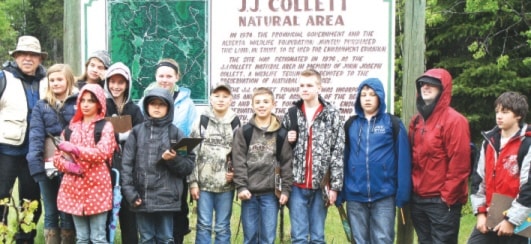Mecca Glen’s sixth graders braved the wind and rain to take a walk through the J.J. Collett Natural Area May 23.
“We go out rain or shine,” Doug Gill, educational co-ordinator, said. “This is a very good group for showing up.”
Mecca Glen is the first group of the season to go.
The class was given ponchos, water bottles, and a wilderness bingo sheet before they head off into the woods.
While the beginning of the walk may not have been interactive, aside from bingo and a worksheet, Gill kept the students of his group entertained with his knowledge of weird wilderness facts.
The students learned that the powder rubbed from the bark of a trembling aspen can be used as sunscreen and that there is a difference between the leaves of a male aspen and a female aspen.
Two minutes into the student’s walk a moose ran from the open are they were entering and into the trees.
Further down the path they were able to see the holes in the trees made by the yellow-bellied sapsucker, a type of woodpecker, and where a porcupine had stripped the bark off a tree.
“You can see moles,” Gill said, pointing to a mound of dirt. “But there are no gophers here.”
The students were able to stand on sand dunes that had been formed by glaciers, and, according to Gill; the wind patterns of the area haven’t changed since the time glaciers moved across the prairies.
Gill had the students stop and look at a group of trees. Clone trees, he explained. They all have the same DNA and come from the same parent tree.
When one tree loses its leaves they all lose their leaves at the same time and, in the fall, change colour at the same time.
Gill also told the students that an abundance of different flowers and fruit grow in the J.J. Collett Natural Area ranging from catkin to wild strawberries. Gill says those who visit the area are able to eat the strawberries.
By Amelia Naismith
